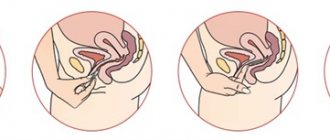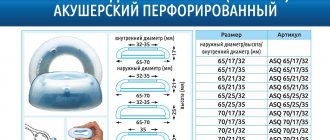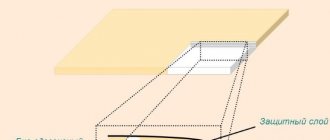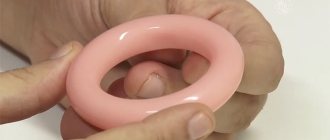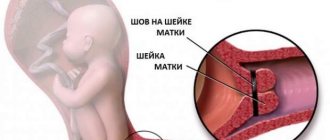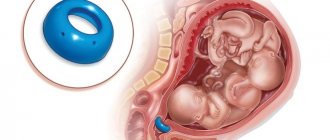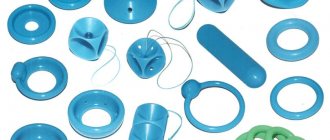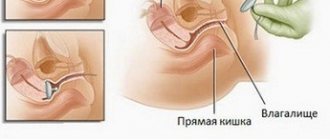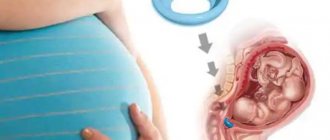A pessary is a gynecological device (vaginal ring) that is used in cases of prolapse or prolapse of the uterus and vagina. It is installed to mechanically hold the walls of the vaginal passage and the body of the uterus when the muscle tissue of the pelvic region or diaphragm is significantly weakened. In gynecology, this pathology is called genital prolapse, and it causes a woman a lot of inconvenience both in her personal and everyday life. Previously, prolapse was treated in the only known way - surgical intervention, which did not always give the desired effect, and besides, not every woman could have surgery. With the advent of the pessary, the treatment of genital prolapse has received an excellent alternative, especially in cases where surgical intervention is contraindicated for various reasons, for example, due to the patient’s age or pregnancy.
The essence of pathology
Going beyond physiological boundaries occurs due to an anatomical defect of the pelvic floor when muscle structures are damaged.
The causes of the pathology
are birth trauma , surgery on the genitals, and hormonal imbalance during menopause.
Multiple births, physically strenuous activities, tumors of internal organs, and chronic constipation predispose to the disease.
Uterine prolapse causes pain, makes urination difficult, interferes with intimate relationships, and creates proctological problems.
Read more about the symptoms of prolapse here.
The protruding part of the uterus can be injured, bleed and ulcerate.
NOTE!
The pathology most often requires surgical treatment. Conservative therapy can help only at the earliest stage of the disease.
What is a uterine ring and its purpose?
A radical method of treating uterine prolapse is not always possible due to concomitant diseases, or when a woman does not want to resort to surgery.
In such cases, doctors recommend using a uterine ring (pessary) - a gynecological device designed to support the body of the uterus during prolapse and prolapse of the organ..
They are made from high-quality hypoallergenic materials and are available in a variety of shapes and sizes. When inserted into the vagina, an elastic and elastic product takes the required shape and prevents displacement of the uterus.
If the use of the uterine ring is supplemented with special gymnastics that strengthens the pelvic muscles, then surgical treatment of the disease can be avoided.
The opinion of doctors on the advisability of using pessaries is not unanimous.
Expert opinion
Shustova Olga Leonidovna
Obstetrician-gynecologist of the highest category
Wearing uterine rings is allowed if there are contraindications to surgery, and if the uterus is not completely prolapsed. The success of the application is influenced by the structure of the genital organs. For women with a short or wide vagina, the use of this device may not bring positive results.
According to statistics, older women more often choose to use a uterine ring instead of surgical treatment. Three quarters of patients have successful experience and positive results.
Main types, shapes and sizes of pessaries
Pessaries or uterine rings are flexible silicone medical products that are designed to create additional support, fix the organ when it is displaced, and also act as a barrier to prevent prolapse of the uterus, rectum, bladder or sagging of the vaginal walls. Due to its elasticity, this device, after being inserted inside, easily takes the desired position and does not at all affect the woman’s freedom of movement and her usual rhythm of life.
Rings vary in shape and size:
- thin;
- curved (Hodge pessaries);
- mushroom-shaped;
- cup regular or perforated;
- tandem;
- urethral;
- calyx-urethral;
- cubic;
- adaptive.
The diameters of the pessaries are also uneven and vary from a minimum of 50 mm to a maximum of 100 mm. Moreover, according to the type of appointment they distinguish:
- Obstetric rings. Indicated for pregnant women to avoid the threat of premature birth and for the prevention of ICI (isthmic-cervical insufficiency).
- Gynecological rings. Used for prolapse/prolapse of the uterus and organs of the female reproductive system.
Determining and selecting the desired type and size of pessary is exclusively a medical prerogative.
However, it is important to distinguish between vaginal and uterine rings. The former act as a barrier method of contraception, while uterine rings are a therapeutic and prophylactic device. You can buy the necessary pessary in pharmacies or medical equipment stores, but only after consulting a gynecologist.
Advantages:
- Effective therapy for uterine prolapse.
- Help in maintaining pregnancy and preventing the risk of premature birth.
- High effectiveness at any stage of pregnancy and with varying degrees of uterine prolapse.
- Hypoallergenic.
- Safety and ease of use.
- There is absolutely no risk of soft tissue injury.
- A good alternative to surgical treatment (various types of operations are discussed at the link).
Flaws:
- Used mainly as a concomitant orthopedic
correction of uterine prolapse.
- Feeling of discomfort.
- The development of vaginitis (inflammation of the genital organs), bacterial vaginosis.
- Increased discharge.
- Loss of the ring or its pressure on adjacent organs of the genitourinary system due to incorrect size.
Advantages and disadvantages
The advantages of the uterine ring are recognized:
- Fixation of the uterus without surgery.
- Possibility of use at any stage of pathology.
- Injury to the genital organs is excluded.
Disadvantages of use:
- Stretching of the vaginal walls increases the risk of developing an inflammatory process in the genitals.
- Increased vaginal discharge.
- The sensation of a foreign body causes discomfort.
Types of devices
Uterine rings are classified depending on the degree of the disease, the individual structure of the patient’s internal organs and the accompanying disorders.
- Cup and cup perforated - used for mild to moderate uterine prolapse.
- Urethral with a special device that supports the urethra - used for problems with urination caused by disease.
- Calyx-urethral - supports the uterus and urethra. Used for moderate uterine prolapse when there are problems with urinary incontinence.
- Hodge's pessary is a rigid ring with a reinforced deformable element that allows it to take any shape. Used for severe forms of the disease and existing anatomical features of the genital organs.
- Cervical perforated - is a deep cup with a large main and small holes. Intended for moderate uterine prolapse and prevention of premature birth in patients with a shortened cervix.
- A pessary made in a cubic shape without sharp corners. The model is used for a short period of time from 5 to 10 hours for severe prolapse.
- The mushroom-shaped pessary has a thickened stem at the base and is intended for deep insertion. Intended for short-term use.
IMPORTANT!
A properly selected pessary does not cause pain. Currently, uterine rings are made from thermoplastic polyvinyl chloride.
Under the influence of body temperature, the pessary softens and does not put pressure on the vaginal walls.
Contraindications for use are:
- Erosion or inflammation of the cervix.
- Exacerbation of infectious diseases.
- Tumors in the pelvic organs.
- Uterine bleeding.
Correction of prolapse, uterine prolapse
Prolapse (prolapse) of the vagina and uterus is characterized by sagging of the vaginal walls and displacement of the uterus downward in the direction of the vaginal outlet.
The descending uterus “pulls” the urethra and bladder with it, which leads to urinary incontinence during laughing, sneezing, coughing and lifting heavy objects.
Prolapse of the rectal wall is accompanied by stool retention, leading to the development of chronic constipation, and in severe cases, it forces a woman to help herself with her hands during bowel movements.
Prolapse of the walls of the vagina and uterus is a general indication for the use of a gynecological pessary, but how to decide on its shape? In addition, the constant wearing of a pessary is not recommended for all patients, which means the question arises - how to use the pessary correctly?
The shape and size of the pessary is determined by the attending physician. When selecting a pessary, the degree of prolapse of the genital organs, the condition and size of the vagina and cervix, the woman’s age and her ability to self-care are taken into account, in particular, the possibility of mastering the technique of using a pessary independently.
Weakness of the pelvic floor muscles is the main factor in the development of genital prolapse. Prolapse of the genital organs as such may not yet exist, but the conditions for prolapse of the pelvic organs may already have been created.
Weakness of the pelvic floor muscles is often observed after childbirth, especially if it was difficult, the fetus was large or there were several of them, obstetric aid and perineotomy were used during childbirth - dissection of the perineum in order to shorten the period of expulsion and reduce the load on the child.
The weakening of the perineal muscles is facilitated by heavy physical labor and work that requires prolonged standing. Often prolapse coexists with chronic respiratory diseases, accompanied by cough and chronic constipation, forcing a woman to strain during bowel movements.
Among the causes of prolapse, passion for heavy sports and hereditary weakness of connective tissue are not the least.
If there is no prolapse as such yet, but a series of tests reveal weakness of the perineal muscles, in any situations accompanied by an increase in intra-abdominal pressure, the use of a gynecological pessary is indicated.
The ideal option for the prevention of prolapse in this case is a cubic pessary (perforated and without perforation), which is easy to use independently, that is, install and remove on your own, without the help of a doctor or midwife.
To restore the tone of the perineum, it is recommended to train the pelvic floor muscles using vaginal simulators, for example, ColpoTrain vaginal cones from ZAO MP Simurg.
Prolapse of the vagina and uterus of the first degree is characterized by the absence of signs of prolapse in a calm state and a slight protrusion of one or two vaginal walls from the genital slit during straining.
The first degree of vaginal prolapse does not require the constant use of a pessary; it can be used occasionally, for example, during sports training or physical labor, accompanied by prolonged standing and tension of the anterior abdominal wall.
For the first degree of genital prolapse and a woman’s ability to self-care, it is recommended to use a cubic pessary; if it is not possible to acquire the skills to install a pessary on your own, you can opt for a pessary - a thin ring.
For women with disrupted hormonal levels, thinned and vulnerable vaginal mucosa, and stress urinary incontinence, which is more common during menopause and after surgery to remove the ovaries, instead of a thin ring, the constant use of a donut pessary, called a thick ring, is recommended. A thick ring, compared to a thin ring, puts less pressure on the vaginal walls and is less likely to cause the formation of bedsores on the vaginal mucosa.
The second degree of genital prolapse is diagnosed when the uterus descends to the level of the vaginal opening. When straining, the vaginal walls extend beyond the genital slit in the form of a small tubercle. The cervix can be found directly at the entrance of the vagina - it is visible to the naked eye.
Often, second-degree vaginal and uterine prolapse is accompanied by stress urinary incontinence. In this case, the use of a gynecological pessary not only allows you to support the genitals, but also prevents urine leakage when coughing, sneezing, laughing and lifting heavy objects.
The second degree of genital prolapse requires the use of a pessary during the day, regardless of the level of physical activity; the pessary can be removed at night.
The best option in this case is a cubic pessary, which fills the internal volume of the vagina and does not allow the uterus to move downwards.
It is convenient for independent use and is indispensable in cases of pelvic floor defects and a sharp weakening of the perineal muscles, which makes the use of rings ineffective.
If a woman does not have the skills to install a pessary on her own, long-term use of a “ring pessary” type pessary is recommended; if the pelvic floor muscles are weakened, a “cup pessary” is used.
In this case, the pessary is installed by a doctor for a period of 3-4 weeks, after which it is necessary to remove the device, sanitize the vagina and re-install the pessary.
Some women manage to master the technique of installing a ring and a thicket; in this case, sanitation is carried out on their own, and visits to the doctor are scheduled every six months.
The third degree of prolapse of the vagina and uterus is characterized by the extension of most of the vagina and cervix beyond the genital slit. In this case, the body of the uterus remains inside.
As a rule, with the third degree of prolapse, severe weakness of the pelvic floor muscles is observed. Ring pessaries do not hold the uterus; moreover, the body of the uterus can be pushed through the central opening of the pessary, which leads to pinching and severe complications.
Using a cup pessary is possible, but does not always give the desired result. The cubic pessary, thanks to the filling and suction effect, is securely attached to the walls of the vagina and effectively holds the uterus, preventing it from moving downwards.
The third degree of genital prolapse is usually accompanied by urinary incontinence, in which case it is recommended to use a urogynecological urethral cup pessary.
IV degree vaginal and uterine prolapse is essentially prolapse of the genital organs. The walls of the vagina are completely turned outward, forming a hernial sac. The entire uterus is located inside the sac. The formation of a hernia is accompanied by pelvic floor defects and stress urinary incontinence and defecation problems.
Conservative treatment of genital prolapse is very difficult. Ring pessaries and cup pessaries are not retained in the vagina and are squeezed out along with the hernial sac.
The only way out is to use a large cubic pessary that can stick to the walls of the vagina and thereby stay inside.
It must be said that the use of a cubic pessary does not always give results; in this case, only surgery can radically get rid of the problem.
For elderly women who, due to age and concomitant diseases, do not leave home and mostly observe bed rest, it is recommended to use a hard and voluminous mushroom-shaped pessary to correct grade IV prolapse, prevent purulent-trophic diseases of the vagina and decubital ulcers of the cervix. It is not suitable for women leading an active lifestyle, as it gets in the way while moving.
- The selection of a pessary involves an analysis of the symptoms of the disease, an assessment of the general condition and the possibility of independent use of the pessary.
- An examination by a gynecologist is necessary to determine the shape and degree of prolapse of the vagina and uterus, and to assess the condition of the genital tract mucosa for the presence of ulcers and bedsores that prevent the use of a pessary.
The use of a gynecological pessary has its contraindications; during a gynecological examination, the doctor must exclude diseases that prevent conservative correction of prolapse: genital cancer, inflammatory diseases of the vagina and uterus, cervical dysplasia, the presence of a decubital ulcer of the cervix (in some cases).
- As a foreign body that presses on the walls of the vagina, increasing its secretion and impeding the outflow of secretions, the pessary contributes to the development of infection in the vagina. Therefore, before installing a pessary, it is mandatory to examine smears for flora.
- To exclude precancerous diseases and cervical cancer, a cytological analysis of scrapings from the cervix and cervical canal is indicated.
- Ultrasound will help exclude tumor processes in the genital organs.
- For urinary incontinence, a general urinalysis, ultrasound of the bladder and urofluometry are necessary.
A correctly selected pessary should not cause discomfort during use and should not make urination or bowel movements difficult.
If the pessary is small, it will slide off the cervix and fall outward; if it is large, it will put forceful pressure on the vaginal walls, impede blood circulation and cause the formation of bedsores.
Unfortunately, in order to save the patient’s money, the doctor is often forced to select a pessary by eye. Ideally, adaptation (fitting) rings should be used for this.
During the first examination, the doctor assesses the size of the cervix and the capacity of the vaginal vaults, and determines by eye the size range of pessaries: small, medium or large. Based on the inspection, a set of fitting rings is purchased.
The set of try-on rings includes four pessaries that differ from each other in outer and inner diameters (size increments are 5 mm).
During the next visit to the doctor, the actual procedure for selecting a pessary is carried out.
The woman sits in a gynecological chair. A ring is installed in her vagina, the size being appropriate to the eye.
After this, the patient is asked to strain and cough; if the fitting ring falls out, it means it is small, and it is necessary to conduct a test with a larger adaptation pessary.
If the pessary puts pressure on the walls of the vagina and bladder and causes cutting sensations in the urethra, it means that it is too large and you should switch to a smaller ring.
If the selected fitting ring does not cause discomfort and does not fall out when lying down when coughing and straining, the patient is asked to stand up, walk for 10-15 minutes, bend over, sit down, go up and down the stairs - perform those movements that are typical for her lifestyle . To avoid difficulty urinating when using a pessary, it is recommended to visit the toilet.
Based on the size of the appropriate adaptation ring, a permanent pessary is selected.
Taking into account that pessaries intended for permanent use are stiffer than fitting rings, preference is given to a product equal to or 5 mm smaller than a suitable fitting ring.
When choosing a cubic pessary, the preferred size is 5 mm larger than that of the selected adaptation ring. This is due to the fact that the cubic pessary is not a rigid structure and is more often prescribed for grades III–IV prolapse.
The same rule applies to those cases when a cubic pessary is purchased to replace the uterine ring. For example, in the pessary correspondence table you can find information that a ring with a diameter of 60 mm corresponds to “cubes” of the first and second sizes, and only size 2 is preferable.
Rule one and most important:
pessary is a product for individual use. Do not use a pessary that has been or is owned by another person. You do not need to lend a product that belongs to you.
Rule two:
Silicone pessaries are supplied to the retail chain in individual packaging in a non-sterile condition, therefore, during initial installation, as well as during subsequent reuse, disinfection of the product is required.
The pessary should be washed in running water and soap, and after cleaning, disinfected with one of the aldehyde-containing antiseptics. In medical institutions, pessaries are sterilized with steam or hot air - this will not cause damage to the product.
Attention! Silicone pessaries should not be boiled and Vaseline should not be used to treat them (it destroys the silicone). Rule three:
Pessaries with an expired expiration date and/or damaged surface should not be used.
Rule four: to facilitate insertion of the pessary, the entrance to the vagina and the pessary itself should be lubricated with any water-based lubricant.
Women of menopausal age, with a thin and vulnerable vaginal mucosa, are recommended to use a cream with estriol in order to improve regeneration and prevent trophic disorders (ulcers and bedsores).
Attention! Estriol is a hormonal substance, so before using it you should consult your doctor and exclude contraindications. Rule four:
the pessary is installed by the doctor with the patient lying down.
When self-inserting the device, a woman should use the position that is most comfortable for her. Rule five:
the use of a pessary dictates the need for regular preventive examinations and sanitization of the vagina.
Visiting a doctor when using a permanent pessary
Pessaries intended for permanent use are initially installed for 10 days. After this time, you must visit a doctor for an examination, monitoring the position of the pessary in the vagina and assessing the effectiveness of treatment.
The next visit to the doctor is planned in 3-4 weeks. its purpose is vaginal sanitation, necessary to prevent infectious complications, the risk of which increases when using pessaries.
In the future, you need to visit a doctor once every six months.
If the patient is trained to independently install and remove the pessary, she does not need to visit the doctor every 3-4 weeks. Sanitation of the vagina is carried out at home on your own according to the scheme described by the doctor. In this case, it is necessary to visit the antenatal clinic for examination once every 6-7 months.
Attention! The residence time of a cubic and mushroom-shaped pessary in the vagina is limited to 6-7 hours. These pessaries should only be inserted during periods of greatest physical activity and removed at night. Periodically, once a month, it is recommended to carry out a course of vaginal sanitation; you should visit a doctor for a preventive examination once every six months.
Return to previous page
Source: https://pessarii.medicinelux.com/korrekcziya-prolapsa,-opushheniya-matki
How is the installation procedure and instructions for use
The initial installation of the uterine ring is carried out on an outpatient basis by a doctor . To exclude infectious-bacteriological inflammation, the patient must undergo examination.
Before insertion into the vagina, the product must be sterilized.
To facilitate insertion, the pessary is lubricated with Vaseline. The ring is inserted deep to the normal level of the cervix, while the convex side of the product should be turned towards the cervix (examples in the photo).
If the size of the pessary is chosen correctly, the woman does not experience pain or constraint in movements..
If the pessary is installed for a limited period, the doctor will explain how to insert it yourself. The pessary must be sterilized after each removal and before the next use.
At home, disinfection is carried out in a 3% solution of hydrogen peroxide at a temperature of 18 ºС and above . The ring is kept in the solution for at least 3 hours.
After which the product is rinsed with distilled water and dried.
If the uterine ring falls out, this means that the pessary size is chosen incorrectly.
If it is larger than the required size, then it will rub and cause inconvenience. At first, there may be problems with urination and bowel movements.
NuvaRing vaginal ring 1 pc. in Nefteyugansk
Intravaginally
. To achieve a contraceptive effect, NovaRing® must be used according to the instructions.
A woman can independently insert the NuvaRing® vaginal ring into the vagina.
The doctor should inform the woman how to insert and remove the NuvaRing® vaginal ring.
To insert the ring, the woman should choose a comfortable position, such as standing with one leg elevated, squatting, or lying down. The NuvaRing® vaginal ring should be squeezed and inserted into the vagina until the ring is in a comfortable position. The exact position of the ring in the vagina is not decisive for the contraceptive effect
Method of administration
1. Insert the ring into the vagina with one hand, and, if necessary, spread the labia with the other hand
2. Push the ring into the vagina until the ring is in a comfortable position
3. Leave the ring in the vagina for 3 weeks
After administration (see How to start using the drug NuvaRing®
) the ring should be in the vagina continuously for 3 weeks.
It is advisable for a woman to regularly check whether it remains in the vagina. If the ring was accidentally removed, you must follow the instructions in the subsection What to do if the ring was temporarily removed from the vagina.
The NuvaRing® vaginal ring should be removed after 3 weeks, on the same day of the week when the ring was inserted into the vagina. After a week's break, a new ring is inserted (for example, if the NuvaRing® vaginal ring was installed on Wednesday at approximately 10:00 pm, it should be removed on Wednesday 3 weeks later at approximately 10:00 pm. A new ring is inserted on the next Wednesday). To remove the ring, you need to pick it up with your index finger or squeeze it with your index and middle fingers and pull it out of the vagina
The used ring should be placed in a bag (keep out of the reach of children and pets) and discarded. Bleeding associated with discontinuation of the NuvaRing® drug usually begins 2-3 days after removal of the NuvaRing® vaginal ring and may not completely stop until a new ring is installed.
How to start using NuvaRing®
In the previous cycle, hormonal contraceptives were not used.
The drug NuvaRing® should be administered on the 1st day of the cycle (i.e., on the 1st day of menstruation). It is possible to install a ring on days 2–5 of the cycle, however, in the first cycle in the first 7 days of using the drug NovaRing®, additional use of barrier methods of contraception is recommended.
Switching from combined hormonal contraceptives (CHCs).
A woman should insert the NuvaRing® vaginal ring on the last day of the usual interval between cycles when taking CHC (tablets or patch). If a woman has taken CHC correctly and regularly and is sure that she is not pregnant, she can switch to using the vaginal ring on any day of the cycle. In no case should you exceed the recommended hormone-free interval of the previous method.
Switching from progestogen-only medications (mini-pills, progestin-only oral contraceptives, implants, injectables, or hormone-containing intrauterine systems (IUDs).
A woman taking mini-pills or progestin-only oral contraceptives can switch to using NuvaRing® on any day. The ring is inserted on the day of removal of the implant or IUD. If a woman received injections, then use of the drug NuvaRing® begins on the day when the next injection should have been given. In all these cases, the woman should use a barrier method of contraception for the first 7 days after insertion of the ring.
After an abortion in the first trimester.
A woman can insert the ring immediately after an abortion.
In this case, she does not need additional contraceptives. If the use of the drug NuvaRing® immediately after an abortion is undesirable, you must follow the recommendations given in the subsection. In the previous cycle, hormonal contraceptives were not used
. In the interval, the woman is recommended an alternative method of contraception.
After childbirth or after an abortion in the second trimester.
A woman is recommended to insert the ring no earlier than the 4th week after childbirth (if she is not breastfeeding) or an abortion in the second trimester. If the ring is installed at a later date, it is recommended to use an additional barrier method for the first 7 days. However, if sexual intercourse has already taken place, then before using the drug NuvaRing® it is necessary to exclude pregnancy or wait until the first menstruation.
Deviations from the recommended regime
The contraceptive effect and cycle control may be impaired if a woman does not comply with the recommended regimen. To avoid a decrease in the contraceptive effect, the following recommendations must be followed.
What to do if the break in using the ring is prolonged.
If you had sexual intercourse during a break in using the ring, pregnancy should be ruled out. The longer the break, the higher the likelihood of pregnancy. If pregnancy is ruled out, the woman should insert a new ring into the vagina as quickly as possible. Over the next 7 days, an additional barrier method of contraception, such as a condom, can be used.
What to do if the ring has been temporarily removed from the vagina.
The ring must remain in the vagina continuously for 3 weeks. If the ring is accidentally removed, it should be washed with cold or slightly warm (not hot) water and immediately inserted into the vagina.
- If the ring remains outside the vagina for less than 3 hours, then its contraceptive effect is not reduced. The woman should insert the ring into the vagina as quickly as possible (no later than after 3 hours).
- If the ring was outside the vagina for more than 3 hours during the 1st or 2nd week of use, the contraceptive effect may be reduced. A woman should insert the ring into her vagina as quickly as possible. Over the next 7 days, you must use a barrier method of contraception, such as a condom. The longer the ring was outside the vagina and the closer this period is to the 7-day break in using the ring, the higher the likelihood of pregnancy.
- If the ring was outside the vagina for more than 3 hours on the 3rd week of use, the contraceptive effect may be reduced. The woman should throw away this ring and choose one of the following two methods:
1. Immediately install a new ring (the new ring can be used for the next 3 weeks. There may be no bleeding associated with the cessation of the drug. However, spotting or bleeding in the middle of the cycle is possible).
2. Wait for bleeding associated with the cessation of the drug, and insert a new ring no later than 7 days after removing the previous ring (this option should be chosen only if the regimen of use of the ring was not violated during the first 2 weeks).
What to do in case of prolonged use of the ring.
If the drug NuvaRing® was used for no more than a maximum period of 4 weeks, then the contraceptive effect remains sufficient. A woman can take a week's break from using the ring and then insert a new ring.
If the NuvaRing® vaginal ring remains in the vagina for more than 4 weeks, the contraceptive effect may worsen, so pregnancy must be excluded before inserting a new ring. If a woman does not adhere to the recommended regimen and bleeding does not occur after a week's break in using the ring, then pregnancy should be ruled out before introducing a new ring.
How to shift or delay the onset of menstrual bleeding.
To delay menstrual-like withdrawal bleeding, a woman can insert a new ring without a week's break. The next ring must be used for 3 weeks. This may cause spotting or bleeding. Then, after the usual one-week break, the woman returns to regular use of the drug NuvaRing®.
To postpone the onset of bleeding to another day of the week, a woman may be advised to take a shorter break from using the ring (for as many days as necessary). The shorter the interval between using the ring, the higher the likelihood that there will be no bleeding occurring after the ring is removed, and bleeding or spotting will occur during the use of the next ring.
Children
The safety and effectiveness of NuvaRing® in adolescent girls under 18 years of age have not been studied.
How long to wear?
To avoid circulatory problems, uterine rings should not be used continuously.
As a rule, the product is worn during the day and removed before going to bed.
The total duration of wearing is determined by the attending physician, depending on the severity of the disease and the degree of improvement after starting to use the pessary.
On average they are installed for 1-8 months.
A necessary condition is periodic follow-up examinations to assess the effectiveness of treatment.
Contraindications for use are:
- Erosion or inflammation of the cervix.
- Exacerbation of infectious diseases.
- Tumors in the pelvic organs.
- Uterine bleeding.
- Abnormal location of the organs of the reproductive system.
- Allergic reaction to the material.
CAREFULLY!
In advanced forms of prolapse, the uterine ring can have a temporary and supportive effect, but will not radically solve the problem.

